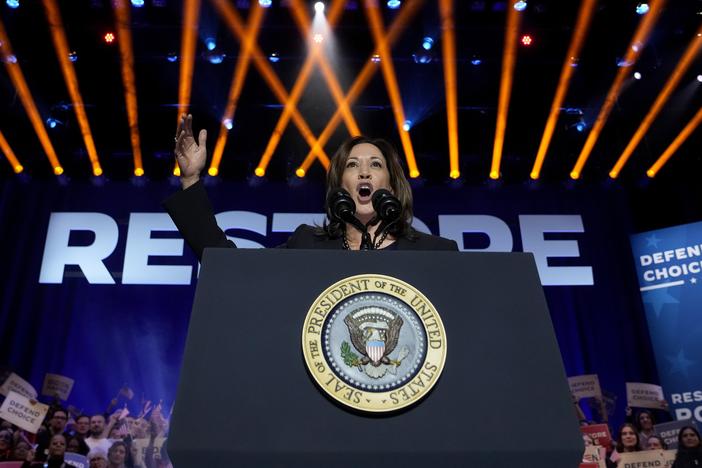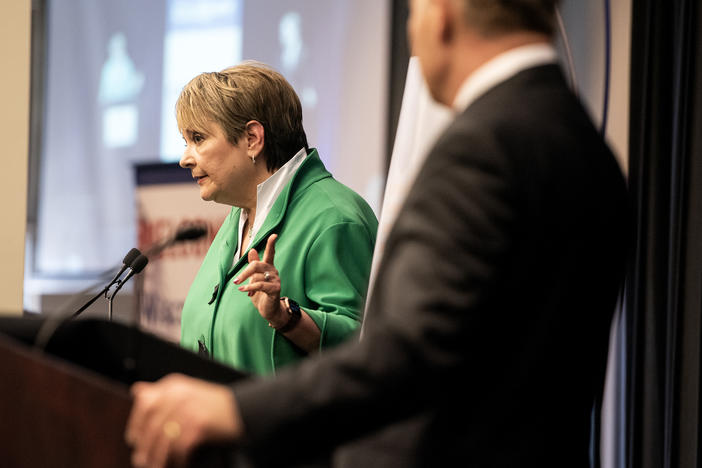Section Branding
Header Content
The Latest On President Trump's Health Status
Primary Content
NPR's Lulu Garcia-Navarro speaks to Dr. Ashish Jha, dean of Brown University's School of Public Health, about President Trump's latest bill of health.
Transcript
LULU GARCIA-NAVARRO, HOST:
In a new memo, President Trump's doctor says his COVID-19 patient is, quote, "no longer considered a transmission risk to others" and that his symptoms have improved. But is he free of the coronavirus or at least out of the woods? Many, many questions remain. Dr. Ashish Jha is the dean of Brown University's School of Public Health, and he joins us now. Good morning.
ASHISH JHA: Good morning. Thank you for having me on.
GARCIA-NAVARRO: Great to have you. This memo from Dr. Sean Conley, dated yesterday, does not say that the president's PCR test was negative or that the coronavirus was not detected. So explain how you might assess a patient not to be a transmission risk if they're still carrying the virus, potentially.
JHA: Yeah. So this note by Dr. Conley was really cryptic and a bit convoluted, but the way we generally assess whether somebody is no longer a transmission risk is by just waiting a certain period of time after they have onset of symptoms. So if they had mild to moderate disease, the evidence says that waiting 10 days after onset of symptoms, they should be - they should no longer be a transmission risk. And if they had more severe disease, you usually have to wait 15 to 20 days before you can clear them for interacting with others.
GARCIA-NAVARRO: Yeah. And it's been just 10 days since President Trump's initial diagnosis of infection, and we now understand that his symptoms were much more severe than had been initially reported.
JHA: Yeah. So, you know, when Dr. Conley says he's cleared after 10 days, that's assuming that he has - you know, he had mild to moderate disease. Also, the president received steroids, and steroids can actually prolong how long somebody is infectious. And that's not taken into account in those time periods I laid out. So I think it's a little bit confusing why Dr. Conley feels as confident as he does that the president is no longer infectious.
GARCIA-NAVARRO: Another cryptic comment - Dr. Conley also said that the president's symptoms had improved, which, of course, isn't the same as saying that the symptoms have gone away. What is the risk of the symptoms getting worse?
JHA: Yeah, so this is, again, an area where I just wish - more clear communication from Dr. Conley would be so helpful. I do think there is a risk. I think the president is more or less coming out of that window where things could get worse, but we've definitely seen people 10, 12 days out after the infection getting quite sick. And obviously, we hope that doesn't happen for the president. So we're not quite out of that window yet.
GARCIA-NAVARRO: What is your assessment of how Dr. Conley has discussed the president's condition?
JHA: Oh, I think it's been a bit of a disaster. I mean, again, this is the president. And when you are cryptic and evasive, you actually create room for a lot of - you know, a lot of conspiracy theories about what might be going on. And I just wish Dr. Conley had been straightforward. It would have made an enormous difference in calming the country down. I don't understand why he's taken the approach that he has.
GARCIA-NAVARRO: President Trump addressed supporters at a White House event yesterday. He spoke without a mask for 18 minutes, and people did not social distance. But he was speaking from a balcony. How do you feel about that?
JHA: Yes, you know, I don't love that. Obviously, I think first of all, he should be wearing a mask around other people. He may still be contagious. Second, the symbol of the president not wearing a mask underscores, you know, kind of the confusing messages coming out of the White House. And this is not a good time to be holding rallies, bringing people together unnecessarily, especially when a lot of people in the audience weren't wearing a mask or social distancing. So it just struck me as unnecessary and risky and potentially harmful.
GARCIA-NAVARRO: Well, let's speak about the broader context because the U.S. is just over 7.7 million infections. Johns Hopkins says more than 214,000 people have died here. We're now seeing daily infections rise again after beginning to drop. Are we looking at the beginning of what's known as the second wave?
JHA: Well, I am really worried, Lulu, that we are heading towards a period of time where case numbers are going to start rising. Hospitalizations will then follow, and then deaths will follow. So, you know, we're looking at a pretty tough fall and winter, and we've got to get ready and do everything we can to protect people and get through this time period.
GARCIA-NAVARRO: Yeah. And just briefly, a WHO official, Dr. David Nabarro, recently asked nations not to use lockdowns as their primary method of controlling the virus. What do you make of that?
JHA: I completely agree. Lockdown should be the effort of last control, of last - you know, sort of our final effort if everything else has failed. We have so many better tools, including mask wearing and avoiding large indoor gatherings, that can keep the virus at bay.
GARCIA-NAVARRO: Dr. Ashish Jha is the dean of Brown University's School of Public Health. Thank you very much.
JHA: Thank you. Transcript provided by NPR, Copyright NPR.
Bottom Content



